-
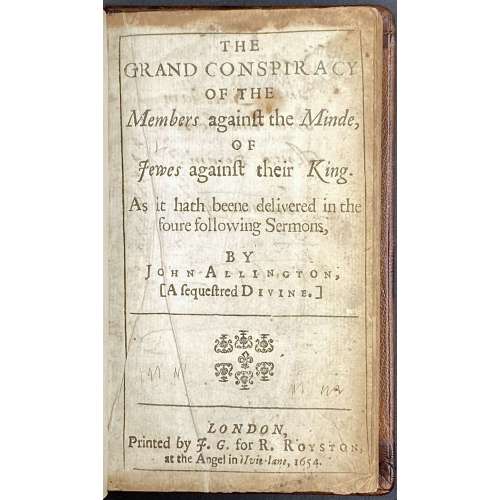 Title: THE | GRAND CONSPIRACY | OF THE | Members again∫t the Minde, | OF | Jewes again∫t their King. | As it hath beene delivered in the | foure following Sermons, | BY | John Allington, [A ∫eque∫tered Divine.] | — | {ornament} | — | LONDON, | Printed by J.G. for R. Royston, | at the Angel in Ivie-lane, 1654.|| Contents: Grand conspiracy of Jewes against their King. A sermon preached in August 1647; Grand conspiracy of Jewes against their King. A sermon preached in January 1649; Grand conspiracy of Jewes against their King. A demonstration of the highest insolencies proceed from men of the lowest and most base extractions Pagination: [2] – t.p. / blank; 1-214. Collation: 12mo; A-I12. Binding: Hardcover; 15 x 9.5 cm, later blind-stamped morocco, raised bands, gilt lettering in compartments. Inscription: Ink by hand by John Bartham, January 30, 1665, to t.p. verso; Pencil by hand to front pastedown: Wing A 1209A.
Title: THE | GRAND CONSPIRACY | OF THE | Members again∫t the Minde, | OF | Jewes again∫t their King. | As it hath beene delivered in the | foure following Sermons, | BY | John Allington, [A ∫eque∫tered Divine.] | — | {ornament} | — | LONDON, | Printed by J.G. for R. Royston, | at the Angel in Ivie-lane, 1654.|| Contents: Grand conspiracy of Jewes against their King. A sermon preached in August 1647; Grand conspiracy of Jewes against their King. A sermon preached in January 1649; Grand conspiracy of Jewes against their King. A demonstration of the highest insolencies proceed from men of the lowest and most base extractions Pagination: [2] – t.p. / blank; 1-214. Collation: 12mo; A-I12. Binding: Hardcover; 15 x 9.5 cm, later blind-stamped morocco, raised bands, gilt lettering in compartments. Inscription: Ink by hand by John Bartham, January 30, 1665, to t.p. verso; Pencil by hand to front pastedown: Wing A 1209A. -
 Iron tsuba of round form, tapering from centre to the rim, decorated with eight roundels – circular emblems of flowers and/or family crests (mon) made of cast brass, pierced and chiselled in kebori, and with flat brass inlay (hira-zōgan) of water plantain (omodaka) and seaweed all over the plate. Hitsu-ana outlined in brass. Four positive silhouette roundels are 3-, 6-, 9-, and 12 – pointing crests/flowers; four negative silhouette roundels – bellflower, cherry and plum blossoms. Yoshirō school (Kaga-Yoshirō). Unsigned. The Momoyama or early Edo period, end of the 16th to the first half of the 17th century (1574-1650). Size: H: 88.3 mm; W: 88.7 mm; Thickness 4.0 mm (Seppa-dai), 3,2 cm (rim). Other Kaga-Yoshiro tsuba in this collection: TSU-0334: 7.7 cm; TSU-0342.2017: 89.6 cm; TSU-0344: 8.1 cm; TSU-0329: 8.0 cm; TSU-0376.2018: 8.1 cm; TSU-0379.2018: 8.2 cm. We see that the usual size is about 8 cm; larger pieces, such as this one and TSU-0342.2017 dedicated to Hachiman, are rare. Article about Yoshiro tsuba.
Iron tsuba of round form, tapering from centre to the rim, decorated with eight roundels – circular emblems of flowers and/or family crests (mon) made of cast brass, pierced and chiselled in kebori, and with flat brass inlay (hira-zōgan) of water plantain (omodaka) and seaweed all over the plate. Hitsu-ana outlined in brass. Four positive silhouette roundels are 3-, 6-, 9-, and 12 – pointing crests/flowers; four negative silhouette roundels – bellflower, cherry and plum blossoms. Yoshirō school (Kaga-Yoshirō). Unsigned. The Momoyama or early Edo period, end of the 16th to the first half of the 17th century (1574-1650). Size: H: 88.3 mm; W: 88.7 mm; Thickness 4.0 mm (Seppa-dai), 3,2 cm (rim). Other Kaga-Yoshiro tsuba in this collection: TSU-0334: 7.7 cm; TSU-0342.2017: 89.6 cm; TSU-0344: 8.1 cm; TSU-0329: 8.0 cm; TSU-0376.2018: 8.1 cm; TSU-0379.2018: 8.2 cm. We see that the usual size is about 8 cm; larger pieces, such as this one and TSU-0342.2017 dedicated to Hachiman, are rare. Article about Yoshiro tsuba. -
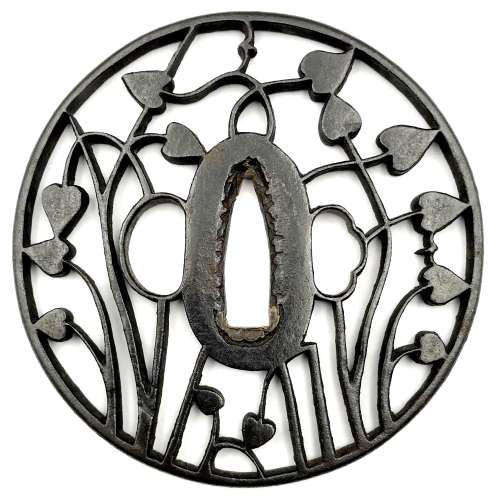 Kyo-sukashi iron tsuba of round form with design of hollyhock (aoi ) and wild geese. Slightly rounded rim. Copper sekigane. Momoyama period, late 16th - early 17th century. Height: 82.6 mm, Width: 82.1 mm, Thickness at seppa-dai: 4.5 mm. NTHK (Nihon Token Hozon Kai) certified.
Kyo-sukashi iron tsuba of round form with design of hollyhock (aoi ) and wild geese. Slightly rounded rim. Copper sekigane. Momoyama period, late 16th - early 17th century. Height: 82.6 mm, Width: 82.1 mm, Thickness at seppa-dai: 4.5 mm. NTHK (Nihon Token Hozon Kai) certified. -
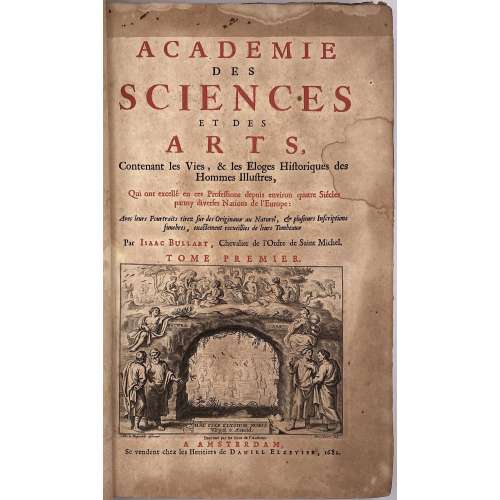 Title: ACADEMIE | DES | SCIENCES | ET DES | ARTS, | Contenant les Vies & les Eloges Historiques des | Hommes Illustres, | Qui ont excellé en ces Professions depuis environ quatre Siécles | parmy diverses Nations de l’Europe : |Avec leurs Pourtraits tirez sur des Originaux au Naturel, & plusieurs Inscriptions | funebres, exactement recueïlies de leurs Tombeaux | Par Isaac Bullart , Chevalier de l’Ordre de Saint Michel. | TOME PREMIER | {allegorical vignette, signed Abr. A Diepenbeke delineavit – Pet. Clouwet sculp.} | Imprimé par les soins de l’Autheur. | A AMSTERDAM, | Se vendent chez les Heritiers de Daniel Elzevier, 1682. || Pagination : [2] – h.t. / blank ; [2] – 1st vol. t.p. in black and red with vignette engraved by Pet. Clouwet after Abr. Diepenbeke / blank; [7] – dedication to Jacques Theodore de Brias {Jacques-Théodore de Bryas (Dutch, 1630 – 1694)}, [9] – preface, [2] – table demonstrative / stanza by Guilielmus Riverius, [2] vinette “Tardius sed grandius” with an elephant in ornamental frame / text; [2] – Advis au lecteur; [1, 2] – f.t. livre premiere, illustres politiques / blank; [2] – noms politiques / blank (A1, after f.t.), 3(A2)-421, [422-424] – table eloges. Collation: [*]6, **8, A6 B-Ggg4. (14 prelim. leaves, as in LIB-2675.2021; the LIB-2676.2021 copy has 12) Binding: 34.5 x 22 x 4.3 cm.34.5 x 22 x 4.3 cm, hardbound; full calf, raised bands. The title is drawn by Abraham van Diepenbeeck (Dutch, 1596 - 1675) and engraved by Peeter Clouwet (Flemish, 1629–1670). The first volume of a two-volume set contains 119 copperplate burin-engraved portraits of selected politicians, historians, jurists, writers, and Italian artists. 26 portraits engraved by Esme de Boulonois (French,1645 – 1681), 3 unsigned, and the rest engraved by Nicolas de Larmessin I (French, 1632 – 1694)Lavinia Vecellio, (Italian, 1530 – 1575), Titian' daughter, engraved by Lamerssin after Titian, Portrait of Jacques Auguste de Thou engraved by de Boulonois after Daniel Dumonstier. Politicians: Antoine Perrenot, Cardinal de Granvelle; Arnaud d'Ossat, Cardinal; Auger Busbeque; Bessarion, Cardinal; François Ximenes, Cardinal; George d'Amboise, Cardinal; Gille Albornoz, Cardinal; Guillaume de Croy; Guy du Faur de Pybrac; Jacques Auguste de Thou; Jean de Selve; Jean Zamoski; Jean de Barnevelt; Jean Armand du Plessis, Cardinal de Richelieu; Jule Mazarin, Cardinal; Michel de l'Hospital; Renaud Pole, Cardinal; Stanislas Hosius, Cardinal; Thomas Morus; Thomas Wolsey, Cardinal. Historians: Bertrand d'Argentré; Cæsar Baronius, Cardinal; Emanuel de Meteren; Enguerand de Monstrelet; Florimond de Remond; François Guicciardin; Fulve Ursin; Guillaume Camden; Henry Catherine d'Avila; Hubert Goltzius; Jacques Amiot; Jean Aventin; Jean Baptiste Platina; Jean Barclay; Jean Froissard; Jean Papirius Masson; Nicolas le Febure; Olivier de la Marche; Onuphre Panuinius; Pandolphe Collenuce; Paul Jove; Philippe de Commines; Pontus Heuterus; Regino Abbé de Prumy; Robert Gaguin; Wolfgang Lazius. Jurists: Alexandre de Tartagnis; André Alciat; André Tiraqueau; Antoine Augustin; Antoine le Febvre; Boece Epo; Charles du Moulin; François Bauduin; Gabriel Mudée; Jacques Cuias; Jason Mainus; Jean Wamese; Mathieu Wesenbec; Philippe Dece; Pierre Peckius; Pierre Pithou; Tibere Decian; Viglius de Zuichem. Writers/Linguists: Ange Politian; Demetrius Chalcondyles; Emanuel Chrysoloras; François Philelphe; François Raphelenge; Guillaume Postel; Jean Argyropilus; Jean Bocace; Jean Lascaris; Jean Passerat; Jean Pierius Valerianus; Jeanne Gray; Nicolas Clenard; Pierre Nannius; Rudolphe Agricola; Theodore Gaza. Italian painters, architects, and sculptors: André Mantegna; André Organa; André del Sarto; André Tafi; André Verrochio; Antoine de Correge; Antoine de Messine; Arnoud di Lappo; Baccio Bandinel; Balthazar Perusi; Bramante d'Urbin; Daniel Ricciarelli; Dominique Beccafumi; Donato; François Mazzuoli; François Primatici; Frere Philippe Lippi; Giorgion; Giotto; Jacques Barozzi de Vignole; Jean Antoine Licinio de Pordenone; Jean Cimabue; Jean d'Udine; Jean François Rustici; Jule Romain; Le Rosso; Leonard de Vinci; Masaccio; Michel-Ange Buonarotti; Perin del Vaga; Philippe Bruneleschi; Philippe Lippi; Polidore de Caravage; Propertia de Rossi; Raphael Sanzio d'Urbin; Sandro Boticelli; Simon Memmi; Taddée Gaddi; Titian Uccello.
Title: ACADEMIE | DES | SCIENCES | ET DES | ARTS, | Contenant les Vies & les Eloges Historiques des | Hommes Illustres, | Qui ont excellé en ces Professions depuis environ quatre Siécles | parmy diverses Nations de l’Europe : |Avec leurs Pourtraits tirez sur des Originaux au Naturel, & plusieurs Inscriptions | funebres, exactement recueïlies de leurs Tombeaux | Par Isaac Bullart , Chevalier de l’Ordre de Saint Michel. | TOME PREMIER | {allegorical vignette, signed Abr. A Diepenbeke delineavit – Pet. Clouwet sculp.} | Imprimé par les soins de l’Autheur. | A AMSTERDAM, | Se vendent chez les Heritiers de Daniel Elzevier, 1682. || Pagination : [2] – h.t. / blank ; [2] – 1st vol. t.p. in black and red with vignette engraved by Pet. Clouwet after Abr. Diepenbeke / blank; [7] – dedication to Jacques Theodore de Brias {Jacques-Théodore de Bryas (Dutch, 1630 – 1694)}, [9] – preface, [2] – table demonstrative / stanza by Guilielmus Riverius, [2] vinette “Tardius sed grandius” with an elephant in ornamental frame / text; [2] – Advis au lecteur; [1, 2] – f.t. livre premiere, illustres politiques / blank; [2] – noms politiques / blank (A1, after f.t.), 3(A2)-421, [422-424] – table eloges. Collation: [*]6, **8, A6 B-Ggg4. (14 prelim. leaves, as in LIB-2675.2021; the LIB-2676.2021 copy has 12) Binding: 34.5 x 22 x 4.3 cm.34.5 x 22 x 4.3 cm, hardbound; full calf, raised bands. The title is drawn by Abraham van Diepenbeeck (Dutch, 1596 - 1675) and engraved by Peeter Clouwet (Flemish, 1629–1670). The first volume of a two-volume set contains 119 copperplate burin-engraved portraits of selected politicians, historians, jurists, writers, and Italian artists. 26 portraits engraved by Esme de Boulonois (French,1645 – 1681), 3 unsigned, and the rest engraved by Nicolas de Larmessin I (French, 1632 – 1694)Lavinia Vecellio, (Italian, 1530 – 1575), Titian' daughter, engraved by Lamerssin after Titian, Portrait of Jacques Auguste de Thou engraved by de Boulonois after Daniel Dumonstier. Politicians: Antoine Perrenot, Cardinal de Granvelle; Arnaud d'Ossat, Cardinal; Auger Busbeque; Bessarion, Cardinal; François Ximenes, Cardinal; George d'Amboise, Cardinal; Gille Albornoz, Cardinal; Guillaume de Croy; Guy du Faur de Pybrac; Jacques Auguste de Thou; Jean de Selve; Jean Zamoski; Jean de Barnevelt; Jean Armand du Plessis, Cardinal de Richelieu; Jule Mazarin, Cardinal; Michel de l'Hospital; Renaud Pole, Cardinal; Stanislas Hosius, Cardinal; Thomas Morus; Thomas Wolsey, Cardinal. Historians: Bertrand d'Argentré; Cæsar Baronius, Cardinal; Emanuel de Meteren; Enguerand de Monstrelet; Florimond de Remond; François Guicciardin; Fulve Ursin; Guillaume Camden; Henry Catherine d'Avila; Hubert Goltzius; Jacques Amiot; Jean Aventin; Jean Baptiste Platina; Jean Barclay; Jean Froissard; Jean Papirius Masson; Nicolas le Febure; Olivier de la Marche; Onuphre Panuinius; Pandolphe Collenuce; Paul Jove; Philippe de Commines; Pontus Heuterus; Regino Abbé de Prumy; Robert Gaguin; Wolfgang Lazius. Jurists: Alexandre de Tartagnis; André Alciat; André Tiraqueau; Antoine Augustin; Antoine le Febvre; Boece Epo; Charles du Moulin; François Bauduin; Gabriel Mudée; Jacques Cuias; Jason Mainus; Jean Wamese; Mathieu Wesenbec; Philippe Dece; Pierre Peckius; Pierre Pithou; Tibere Decian; Viglius de Zuichem. Writers/Linguists: Ange Politian; Demetrius Chalcondyles; Emanuel Chrysoloras; François Philelphe; François Raphelenge; Guillaume Postel; Jean Argyropilus; Jean Bocace; Jean Lascaris; Jean Passerat; Jean Pierius Valerianus; Jeanne Gray; Nicolas Clenard; Pierre Nannius; Rudolphe Agricola; Theodore Gaza. Italian painters, architects, and sculptors: André Mantegna; André Organa; André del Sarto; André Tafi; André Verrochio; Antoine de Correge; Antoine de Messine; Arnoud di Lappo; Baccio Bandinel; Balthazar Perusi; Bramante d'Urbin; Daniel Ricciarelli; Dominique Beccafumi; Donato; François Mazzuoli; François Primatici; Frere Philippe Lippi; Giorgion; Giotto; Jacques Barozzi de Vignole; Jean Antoine Licinio de Pordenone; Jean Cimabue; Jean d'Udine; Jean François Rustici; Jule Romain; Le Rosso; Leonard de Vinci; Masaccio; Michel-Ange Buonarotti; Perin del Vaga; Philippe Bruneleschi; Philippe Lippi; Polidore de Caravage; Propertia de Rossi; Raphael Sanzio d'Urbin; Sandro Boticelli; Simon Memmi; Taddée Gaddi; Titian Uccello. -
 Iron tsuba of a spindle shape (tate-itomaki-gata) pierced and inlaid in brass suemon-zōgan with bellflowers, vines and foliage, and a dragonfly in the upper right corner, on both sides. One of the hitsu-ana plugged with grey metal (led or pewter), nakaga-ana fitted with copper sekigane. The shape of the tsuba may be interpreted as four saddles connected to each other by horse bits. Such a design of sukashi and zōgan is usually attributed to Kaga Yoshirō branch of Heianjo school, active in the second half of the 17th century (c. 1650-1700). Size: 95.9 mm diagonal; 4.1 mm thickness. Tokubetsu Kicho certificate № 332 issued by NBTHK on October 12, 1965.
Iron tsuba of a spindle shape (tate-itomaki-gata) pierced and inlaid in brass suemon-zōgan with bellflowers, vines and foliage, and a dragonfly in the upper right corner, on both sides. One of the hitsu-ana plugged with grey metal (led or pewter), nakaga-ana fitted with copper sekigane. The shape of the tsuba may be interpreted as four saddles connected to each other by horse bits. Such a design of sukashi and zōgan is usually attributed to Kaga Yoshirō branch of Heianjo school, active in the second half of the 17th century (c. 1650-1700). Size: 95.9 mm diagonal; 4.1 mm thickness. Tokubetsu Kicho certificate № 332 issued by NBTHK on October 12, 1965. -
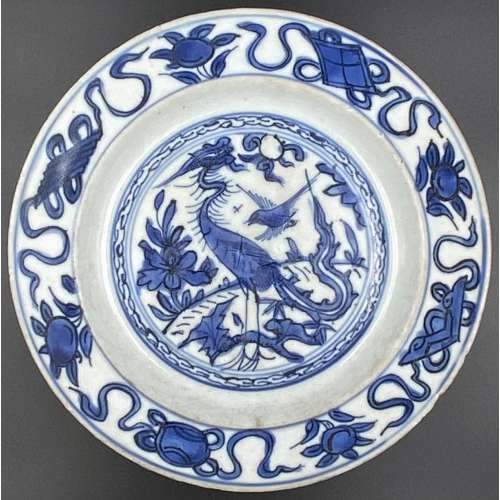 Plate with crane, bird, plants, and four treasures. Porcelain with underglaze blue decoration and illegible factory mark to the bottom. Ming Dynasty [大明] (1368 – 1644); Wanli Era (1572 – 1620); Late 16th – Early 17th century. Diameter: 19.5 cm; Height: 3 cm
Plate with crane, bird, plants, and four treasures. Porcelain with underglaze blue decoration and illegible factory mark to the bottom. Ming Dynasty [大明] (1368 – 1644); Wanli Era (1572 – 1620); Late 16th – Early 17th century. Diameter: 19.5 cm; Height: 3 cm -
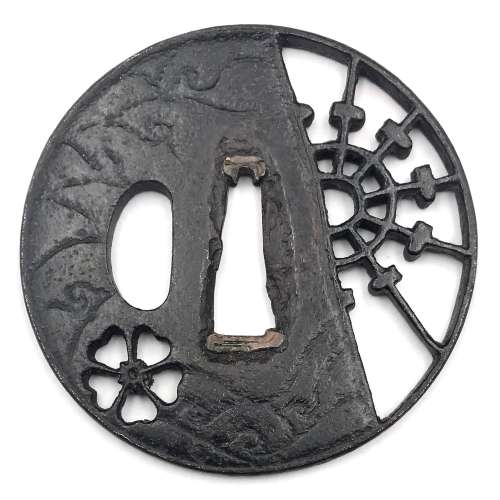 Iron tsuba of round form decorated with design of sea waves in low relief carving (kebori) and pierced with design of cherry blossom in negative silhouette (in-sukashi) and water wheel in positive silhouette (ji-sukashi). The solid portion of the plate has a shallow groove just before the edge. Copper sekigane. School attribution is unclear. Unsigned. Momoyama period, 16th - 17th century. Dimensions: Height: 70.3 mm, width: 71.1 mm, thickness at seppa-dai: 4.4 mm, at rim 4.1 mm. Provenance: Robert E. Haynes, Mark Weisman. This is what shibuiswords.com says about this tsuba:
Iron tsuba of round form decorated with design of sea waves in low relief carving (kebori) and pierced with design of cherry blossom in negative silhouette (in-sukashi) and water wheel in positive silhouette (ji-sukashi). The solid portion of the plate has a shallow groove just before the edge. Copper sekigane. School attribution is unclear. Unsigned. Momoyama period, 16th - 17th century. Dimensions: Height: 70.3 mm, width: 71.1 mm, thickness at seppa-dai: 4.4 mm, at rim 4.1 mm. Provenance: Robert E. Haynes, Mark Weisman. This is what shibuiswords.com says about this tsuba:"A very unusual iron plate tsuba. The solid plate is carved with waves on both sides. A cherry bloom in sukashi, lower left, and the right third of the plate in openwork with design of a water wheel. The rim with some iron bones. The hitsu-ana is original but the shape may have been slightly changed. One would expect this to be the work of the early Edo period, but the age of the walls of the sukashi would suggest that this is a work of the middle Muromachi period. This must be the forerunner for the Edo examples we see of this type of design." (Haynes)
I managed to find a look-a-like tsuba in Haynes Catalog #5, 1983, pp. 20-21, №44: "Typical later Heianjo brass inlay example. Ca. 1725. Ht. 7 cm., Th. 4.5 mm., $100/200".We see that the plate design of both tsuba is the same, and the only difference is the trim. It would be logical to assume that both pieces were made at about the same time, rather than 225 years apart. To be fair, let's accept that they were made in Momoyama period.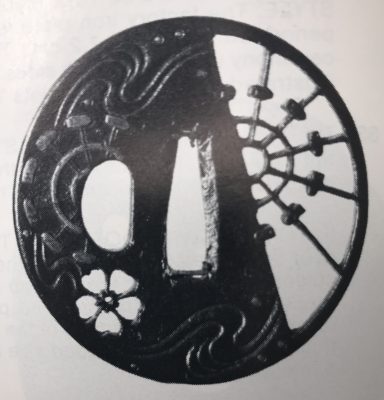
Haynes Catalog #5, 1983, pp. 20-21, №44.
-
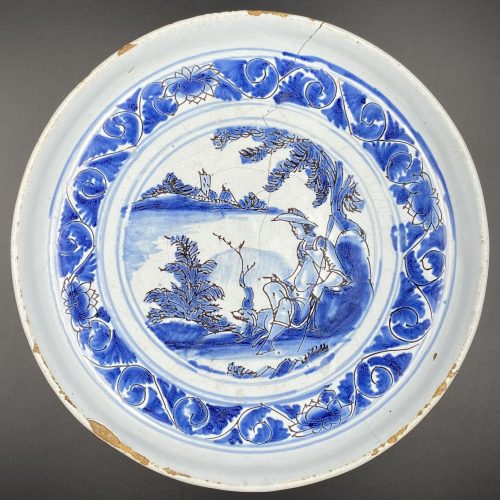 Nevers faience footed plate with a hunter and his dog on a mound, in blue over white. Dimensions: Diameter 22.3 cm; H: 3.5 cm. Seller's description: Plat rond en faïence à décor en camaïeu bleu d'un personnage et son chien sur un tertre feuillagé dans un médaillon, frise d'entrelacs. Fin XVIIème.
Nevers faience footed plate with a hunter and his dog on a mound, in blue over white. Dimensions: Diameter 22.3 cm; H: 3.5 cm. Seller's description: Plat rond en faïence à décor en camaïeu bleu d'un personnage et son chien sur un tertre feuillagé dans un médaillon, frise d'entrelacs. Fin XVIIème. -
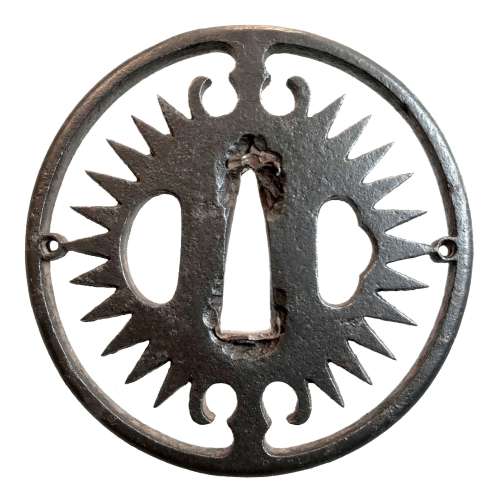 Iron tsuba of round form with design of slanting rays of light (shakoh) or clock gear (tokei) in openwork (sukashi). Commonly considered a Christian / Jesuit motif. Copper sekigane. According to seller, Owari School. Haynes writes that most tsuba of this design are Owari (Tsuba. Aesthetic Study). Unsigned. Edo period. According to F. Geyer, diamond-shaped vertical posts and long rays suggest that this tsuba was probably made between 1605 and 1630.
Iron tsuba of round form with design of slanting rays of light (shakoh) or clock gear (tokei) in openwork (sukashi). Commonly considered a Christian / Jesuit motif. Copper sekigane. According to seller, Owari School. Haynes writes that most tsuba of this design are Owari (Tsuba. Aesthetic Study). Unsigned. Edo period. According to F. Geyer, diamond-shaped vertical posts and long rays suggest that this tsuba was probably made between 1605 and 1630.Size: 76.9 x 76.0 x 5.4 mm
For information regarding shakoh tsuba see article 'Kirishitan Ikenie Tsuba by Fred Geyer at Kokusai Tosogu Kai; The 2nd International Convention & Exhibition, October 18-23, 2006, pp. 84-91. -
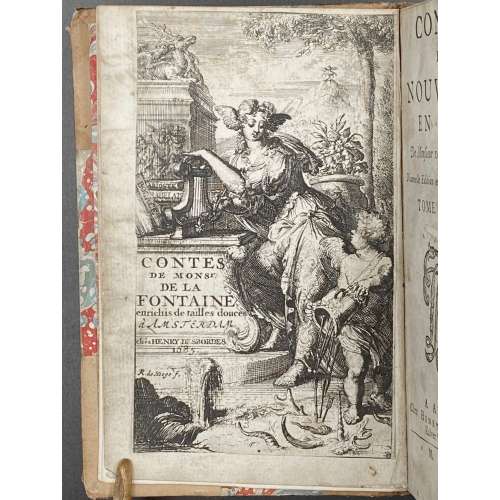 [Jean de LA FONTAINE]. Contes et nouvelles en vers. De Monsieur de La Fontaine. Nouvelle édition enrichie de tailles-douces. À Amsterdam | Chez Henry Desbordes, MDCLXXXV [1685]. — 2 vol. in 1. Pagination: [1] - frontispiece with pasted illustr., [*1] - title p. with blank verso, *2-*5 (only recto numbered) - advertisement, [1] - preface vol. 1, [2] table, 1-236; [6] - preface vol. 2, 1-216, illustr. (in text). Etched frontispiece plate and 58 half-page etchings at the head of each chapter as well as endpiece vignettes, all by R. de Hooge (Romeyn de Hooghe, 1645 – 1708, a Dutch painter, sculptor, engraver and caricaturist. First illustrated edition. "Publication of the scandalous fables was forbidden in France from 1674. According to Van Eeghen, this edition was published without the knowledge of La Fontaine. ...This is the edition with ‘Le Juge de Nêle’ (instead of Mesle) in the contents of the first volume, as well as page 211 for 'Dissertation sur la Joconde'; 16 lines of text on page 211; and 19 lines of text on the first page of the preface of volume 2" [1]. Pott 8vo (15.4 x 10 cm), hardcover; owner's later tan polished half-calf, marbled boards, marbled pastedowns and flyleaves, 5 raised bands, dark brown labels with gilt lettering and gilt roll patterns on spine, tail of the spine slightly damaged. Corners bumped, spotted stains on leather. Henri Desbordes (d. ca. 1722) was a Huguenot printer who was exiled from his business in France and set up as a publisher in Amsterdam in the 17th century.
[Jean de LA FONTAINE]. Contes et nouvelles en vers. De Monsieur de La Fontaine. Nouvelle édition enrichie de tailles-douces. À Amsterdam | Chez Henry Desbordes, MDCLXXXV [1685]. — 2 vol. in 1. Pagination: [1] - frontispiece with pasted illustr., [*1] - title p. with blank verso, *2-*5 (only recto numbered) - advertisement, [1] - preface vol. 1, [2] table, 1-236; [6] - preface vol. 2, 1-216, illustr. (in text). Etched frontispiece plate and 58 half-page etchings at the head of each chapter as well as endpiece vignettes, all by R. de Hooge (Romeyn de Hooghe, 1645 – 1708, a Dutch painter, sculptor, engraver and caricaturist. First illustrated edition. "Publication of the scandalous fables was forbidden in France from 1674. According to Van Eeghen, this edition was published without the knowledge of La Fontaine. ...This is the edition with ‘Le Juge de Nêle’ (instead of Mesle) in the contents of the first volume, as well as page 211 for 'Dissertation sur la Joconde'; 16 lines of text on page 211; and 19 lines of text on the first page of the preface of volume 2" [1]. Pott 8vo (15.4 x 10 cm), hardcover; owner's later tan polished half-calf, marbled boards, marbled pastedowns and flyleaves, 5 raised bands, dark brown labels with gilt lettering and gilt roll patterns on spine, tail of the spine slightly damaged. Corners bumped, spotted stains on leather. Henri Desbordes (d. ca. 1722) was a Huguenot printer who was exiled from his business in France and set up as a publisher in Amsterdam in the 17th century. -
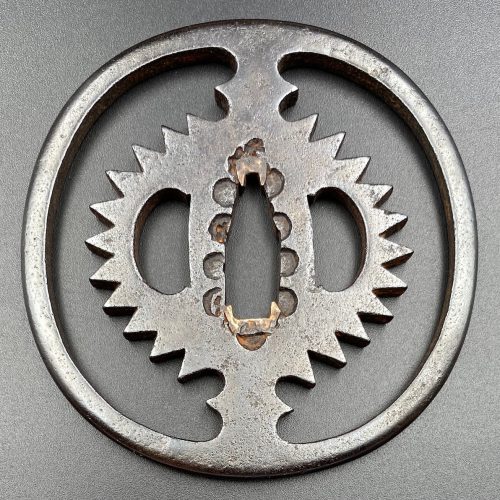 Iron tsuba of round form pierced with the design of slanting rays of light (Christian motif, Jesuit’s IHS symbol) in positive silhouette (ji-sukashi). This design is often called “tokei” [時計], or “clock gear”. Nakaga-ana fitted with copper sekigane. Rounded rim. Unsigned. Higo school. Early Edo period, mid-17th century (1632-1650).
Iron tsuba of round form pierced with the design of slanting rays of light (Christian motif, Jesuit’s IHS symbol) in positive silhouette (ji-sukashi). This design is often called “tokei” [時計], or “clock gear”. Nakaga-ana fitted with copper sekigane. Rounded rim. Unsigned. Higo school. Early Edo period, mid-17th century (1632-1650).Size: 78.3 x 77.0 x 5.3 mm
For information regarding this type of tsuba see the article 'Kirishitan Ikenie Tsuba by Fred Geyer at Kokusai Tosogu Kai; The 2nd International Convention & Exhibition, October 18-23, 2006, pp. 84-91. School and age attribution thanks to Bruce Kirkpatrick. . 
IHS emblem of the Jesuits
-
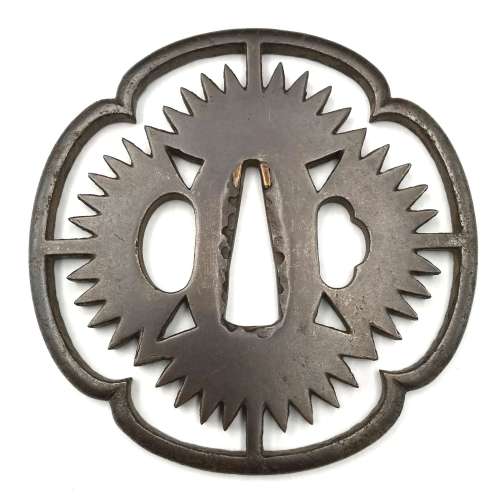 Iron tsuba of mokko form with slanting rays of light (shakoh) Christian motif (Jesuit's IHS symbol) in openwork (sukashi). Traditional description of this kind of design is called "tokei", or "clock gear". Owari school. Edo period.
Iron tsuba of mokko form with slanting rays of light (shakoh) Christian motif (Jesuit's IHS symbol) in openwork (sukashi). Traditional description of this kind of design is called "tokei", or "clock gear". Owari school. Edo period.Size: 83.4 x 83.1 x 4.4 mm
NTHK certified KANTEISHO ("Important Work"). In a custom wooden box. For information regarding shakoh tsuba see article 'Kirishitan Ikenie Tsuba by Fred Geyer at Kokusai Tosogu Kai; The 2nd International Convention & Exhibition, October 18-23, 2006, pp. 84-91. -
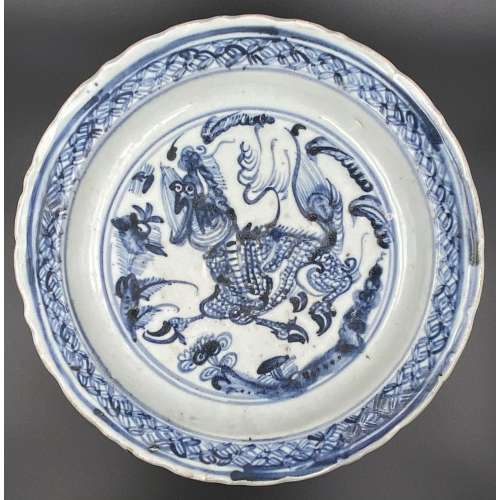 Footed plate with scalloped rim, centre decorated with running yak or another even-toed animal among flowers, jewel diaper pattern to the inner lip; foliage motif to the outside is bordered with foliage above and lotus leaves below. Porcelain with underglaze blue decoration. Ming Dynasty [大明] (1368 – 1644); Wanli Era (1572 – 1620); Late 16th – Early 17th century. Diameter: 25.5 cm; Height: 4.2 cm
Footed plate with scalloped rim, centre decorated with running yak or another even-toed animal among flowers, jewel diaper pattern to the inner lip; foliage motif to the outside is bordered with foliage above and lotus leaves below. Porcelain with underglaze blue decoration. Ming Dynasty [大明] (1368 – 1644); Wanli Era (1572 – 1620); Late 16th – Early 17th century. Diameter: 25.5 cm; Height: 4.2 cm -

Tsuba of oval form decorated with vines, tendrils, and leaves on trellis in brass inlay with details carved in kebori, and pierced with six family crests (mon) with two, three and four pointing stars in openwork, each outlined with brass wire and carved in kebori. Original hitsu-ana outlined with brass wire was probably enlarged later. Copper sekigane.
Momoyama to early Edo period (end of the 16th - beginning of the 17th century). Dimensions: 68.3 x 64.5 x 3.4 mm. -
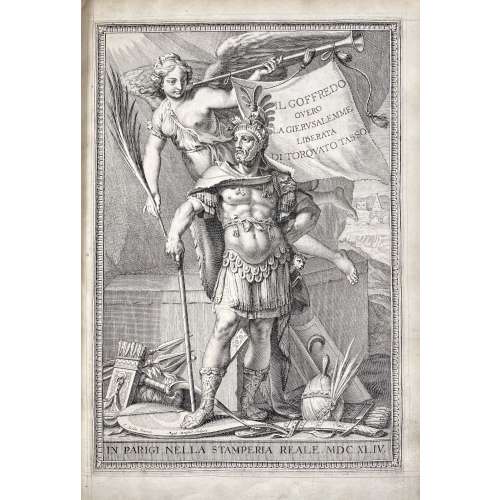 Title page: IL | GOFFREDO | OVERO | LA | GIERUSALEMME | LIBERATA | DI TORQUATO TASSO. || Engraved title: On the banner: IL GOFFREDO | OVERO | LA GIERUSALEMME | LIBERATA | DI TORQUATO TASSO ||; under the image, within frame: IN PARIGI NELLA STAMPERIA REALE MDC XLIV. Signed: J. Stella Invenit — Ægid Rousselet Sculpsit (with tall “s”) || Collation: 2 blank leaves with donation ink inscription to recto of the 1st: “Ex Dono Patruelis Do Roberto Willughby” [i.e. Robert Willoughby]; t.p. / blank, engraved t.p. by Gilles Rousselet after Jacques Stella / blank, “Allegoria dell poema” 4 leaves, 1st two leaves signed iij and iiij, respectively; π6 A-Z4 Aa-Zz4 Aaa-Rrr4, 2 blank leaves at the end; text paginated from 1 to 502 [2] (p. 503 tailpiece, p. 504 blank); a printable area marked with vertical and horizontal double lines; total: 252 leaves of text (504 pages), 6 prelims and 4 blanks. Illustrated throughout with head- and tailpieces, and historiated initials. Binding: 18th-century red crushed morocco, triple-fillet gilt border, triple-fillet gilt frame, panel with gilt lozenge centrepiece, lozenges at corners, marbled endpapers, AEG, crudely rebacked retaining original spine with raised bands, gilt in compartments, crimson label with gilt lettering; The Robin Collection bookplate to front pastedown. Provenance: The Robin Collection; Robert Willoughby family. Contributors: Torquato Tasso (Italian, 1544 –1595) – author. Jacques Stella (French, 1596 – 1657) – artist. Gilles [Aegidius] Rousselet (French, 1610 – 1686) – engraver.
Title page: IL | GOFFREDO | OVERO | LA | GIERUSALEMME | LIBERATA | DI TORQUATO TASSO. || Engraved title: On the banner: IL GOFFREDO | OVERO | LA GIERUSALEMME | LIBERATA | DI TORQUATO TASSO ||; under the image, within frame: IN PARIGI NELLA STAMPERIA REALE MDC XLIV. Signed: J. Stella Invenit — Ægid Rousselet Sculpsit (with tall “s”) || Collation: 2 blank leaves with donation ink inscription to recto of the 1st: “Ex Dono Patruelis Do Roberto Willughby” [i.e. Robert Willoughby]; t.p. / blank, engraved t.p. by Gilles Rousselet after Jacques Stella / blank, “Allegoria dell poema” 4 leaves, 1st two leaves signed iij and iiij, respectively; π6 A-Z4 Aa-Zz4 Aaa-Rrr4, 2 blank leaves at the end; text paginated from 1 to 502 [2] (p. 503 tailpiece, p. 504 blank); a printable area marked with vertical and horizontal double lines; total: 252 leaves of text (504 pages), 6 prelims and 4 blanks. Illustrated throughout with head- and tailpieces, and historiated initials. Binding: 18th-century red crushed morocco, triple-fillet gilt border, triple-fillet gilt frame, panel with gilt lozenge centrepiece, lozenges at corners, marbled endpapers, AEG, crudely rebacked retaining original spine with raised bands, gilt in compartments, crimson label with gilt lettering; The Robin Collection bookplate to front pastedown. Provenance: The Robin Collection; Robert Willoughby family. Contributors: Torquato Tasso (Italian, 1544 –1595) – author. Jacques Stella (French, 1596 – 1657) – artist. Gilles [Aegidius] Rousselet (French, 1610 – 1686) – engraver. -
 Iron tsuba decorated with sparrows and bamboo inlaid and chiseled in yellow brass, with snow lying on bamboo leaves inlaid in silver-ish shibuichi. Copper sekigane. The kogai-hitsu-ana probably cut out at a later date. Heianjō school. Unsigned. Height: 86.0 mm, Width: 85.4 mm, Thickness at seppa-dai: 2.9 mm. Momoyama or early Edo period, first half of the 17th century. Merrily Baird, Symbols..., page 118: "The association of the sparrow (suzume) with both bamboo and rice heads is an old one found in Japanese poetry, paining, and design."
Iron tsuba decorated with sparrows and bamboo inlaid and chiseled in yellow brass, with snow lying on bamboo leaves inlaid in silver-ish shibuichi. Copper sekigane. The kogai-hitsu-ana probably cut out at a later date. Heianjō school. Unsigned. Height: 86.0 mm, Width: 85.4 mm, Thickness at seppa-dai: 2.9 mm. Momoyama or early Edo period, first half of the 17th century. Merrily Baird, Symbols..., page 118: "The association of the sparrow (suzume) with both bamboo and rice heads is an old one found in Japanese poetry, paining, and design." -
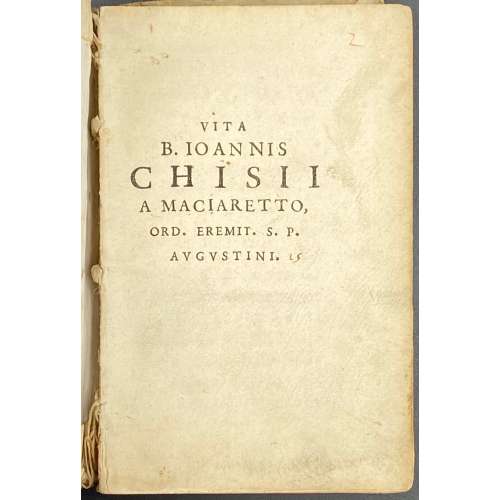 [Michael Hoyer]. Vita B. Ioannis Chisii a Maciaretto, ord. ermit. s. p. Augustini. — Antverpiæ, Apud Henricum Aertssens, Anno MDCXLI [1641]. Pagination: [2] *3+recto unpag. *4+recto unpag., [10], 5-135 [3]. Illustrations: Frontispiece missing, 4 copperplate engravings (pp. 22, 64, 90, and 120) by Pieter de Jode the Younger (1606–1674, Flemish printmaker, draughtsman, painter and art dealer) after Erasmus Quellinus the Younger (1607–1678, Flemish painter, engraver, draughtsman and tapestry designer). Size: Pott 8vo (15.5 x 10 cm), vellum binding. Expanded title: Vita Beati Ioannis Chisii, a Maciaretto, Ordinis Eremitarum Sancti Patris Augustini. [Translation: Life of Blessed Giovanni Chigi from Maciaretto, Order of Hermits of St. Augustine]. Blessed Giovanni Chigi (1300 - 1363) [1] was a lay brother of the Order of Hermits of St. Augustine. The Chigi family is a Roman princely family of Sienese extraction descended from the counts of Ardenghesca. The earliest authentic mention of them is in the 13th century, with one Alemanno, counsellor of the Republic of Siena. The Wikipedia article does not mention Giovanni Chigi, however, it states that one of the Chigi, Cardinal Fabio Chigi, was elected pope as Alexander VII at the Conclave of 1655. The book was published in 1641 with a dedication to the said Cardinal Fabio Chigi before he was elected pope. The town, Maciaretto, where Giovanni Chigi was from, is unclear because there is no such place in modern Italy, and there are two places called Macereto: (1) Macereto Alta/Basso in Perugia province and (2) Macereto in the municipality of Visso, in the province of Macerata, region Marche. I assume that our Giovanni Chigi was from the one that is closer to Siena, i.e. Macereto in Perugia province. Regarding the author. There is no author's name in the book. However, in various sources, the book is mentioned as written by Michel Hoyer, who was born in Hesdin, Flanders in 1593 and died in 1650. He pursued an ecclesiastical career and professed rhetoric at the College of Saint Pierre in Lille. He later joined the Order of Saint Augustine, in the convent of Ypres, and settled in various schools in the Netherlands. His reputation attracted many students, among them Albert Rubens (1614–1657), the eldest son of Peter Paul Rubens and Isabella Brant. Michel Hoyer wrote several books, the most known is Flammulae amoris, S.P. Augustini versibus et iconibus exornatae:
[Michael Hoyer]. Vita B. Ioannis Chisii a Maciaretto, ord. ermit. s. p. Augustini. — Antverpiæ, Apud Henricum Aertssens, Anno MDCXLI [1641]. Pagination: [2] *3+recto unpag. *4+recto unpag., [10], 5-135 [3]. Illustrations: Frontispiece missing, 4 copperplate engravings (pp. 22, 64, 90, and 120) by Pieter de Jode the Younger (1606–1674, Flemish printmaker, draughtsman, painter and art dealer) after Erasmus Quellinus the Younger (1607–1678, Flemish painter, engraver, draughtsman and tapestry designer). Size: Pott 8vo (15.5 x 10 cm), vellum binding. Expanded title: Vita Beati Ioannis Chisii, a Maciaretto, Ordinis Eremitarum Sancti Patris Augustini. [Translation: Life of Blessed Giovanni Chigi from Maciaretto, Order of Hermits of St. Augustine]. Blessed Giovanni Chigi (1300 - 1363) [1] was a lay brother of the Order of Hermits of St. Augustine. The Chigi family is a Roman princely family of Sienese extraction descended from the counts of Ardenghesca. The earliest authentic mention of them is in the 13th century, with one Alemanno, counsellor of the Republic of Siena. The Wikipedia article does not mention Giovanni Chigi, however, it states that one of the Chigi, Cardinal Fabio Chigi, was elected pope as Alexander VII at the Conclave of 1655. The book was published in 1641 with a dedication to the said Cardinal Fabio Chigi before he was elected pope. The town, Maciaretto, where Giovanni Chigi was from, is unclear because there is no such place in modern Italy, and there are two places called Macereto: (1) Macereto Alta/Basso in Perugia province and (2) Macereto in the municipality of Visso, in the province of Macerata, region Marche. I assume that our Giovanni Chigi was from the one that is closer to Siena, i.e. Macereto in Perugia province. Regarding the author. There is no author's name in the book. However, in various sources, the book is mentioned as written by Michel Hoyer, who was born in Hesdin, Flanders in 1593 and died in 1650. He pursued an ecclesiastical career and professed rhetoric at the College of Saint Pierre in Lille. He later joined the Order of Saint Augustine, in the convent of Ypres, and settled in various schools in the Netherlands. His reputation attracted many students, among them Albert Rubens (1614–1657), the eldest son of Peter Paul Rubens and Isabella Brant. Michel Hoyer wrote several books, the most known is Flammulae amoris, S.P. Augustini versibus et iconibus exornatae: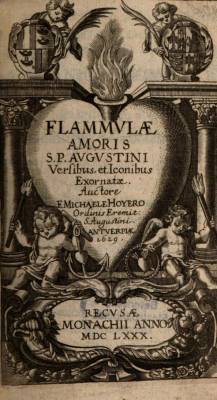 Surprisingly, there is only limited information about Michel Hoyer in Spanish Wikipedia; other language versions of his biography do not exist. Another author mentioned in the book is some anonymous Augustinian from Cologne.
Regarding the illustrations. In our copy, the frontispiece is missing. It was probably ripped off by some unscrupulous seller of antique prints.
The image on the missing frontispiece is this:
Surprisingly, there is only limited information about Michel Hoyer in Spanish Wikipedia; other language versions of his biography do not exist. Another author mentioned in the book is some anonymous Augustinian from Cologne.
Regarding the illustrations. In our copy, the frontispiece is missing. It was probably ripped off by some unscrupulous seller of antique prints.
The image on the missing frontispiece is this:
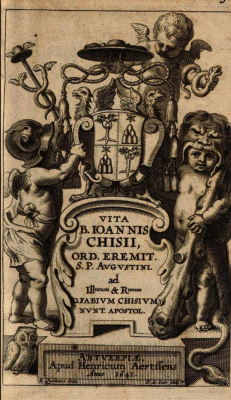 The names of the artists engraved in the bottom of the stone: E. Quellinus, delin. to the left and P. de Jode, fecit. to the right. We can infer that the other illustrations in that book are produced by the same duo. The image represents three cherubs: one with Athena's serpent in his left hand and a cardinal's hat in his right hand; another in Athen's helmet on his head and her owl beside his feet, with the staff of Mercurius (serpent-twined staff adorned with a winged hat) in his left hand, and the House of Chigi - Della Rovere coat of arms in his right hand; the third cherub depicted with the Hercules attributes - lion pelt and a club.
Regarding the publisher. Henricum Aertssens or Hendrik Aertssen, 1586-1658. Besides the other books, he published PIA DESIDERIA by Herman Hugo in 1636 [1621 french edition by Jean Cnobbartin in Antwerp in his collection LIB-1657.2018]. According to Nina Lamal [2], nothing is known about career of this publisher, besides what's said in Adresboek van zeventiende-eeuwse drukkers, uitgevers en boekverkopers in Vlaanderen / Directory of seventeenth-century Printers, Publishers and Booksellers in Flanders / Vlieger-De Wilde, Koen De (editor). The list of his publications can be seen here.
Other artists who turned to the figure of Blessed Giovanni Chigi were Abraham van Diepenbeeck (painter) and Conrad Lauwers (engraver). The print is in Rijksmuseum, in Amsterdam.
The names of the artists engraved in the bottom of the stone: E. Quellinus, delin. to the left and P. de Jode, fecit. to the right. We can infer that the other illustrations in that book are produced by the same duo. The image represents three cherubs: one with Athena's serpent in his left hand and a cardinal's hat in his right hand; another in Athen's helmet on his head and her owl beside his feet, with the staff of Mercurius (serpent-twined staff adorned with a winged hat) in his left hand, and the House of Chigi - Della Rovere coat of arms in his right hand; the third cherub depicted with the Hercules attributes - lion pelt and a club.
Regarding the publisher. Henricum Aertssens or Hendrik Aertssen, 1586-1658. Besides the other books, he published PIA DESIDERIA by Herman Hugo in 1636 [1621 french edition by Jean Cnobbartin in Antwerp in his collection LIB-1657.2018]. According to Nina Lamal [2], nothing is known about career of this publisher, besides what's said in Adresboek van zeventiende-eeuwse drukkers, uitgevers en boekverkopers in Vlaanderen / Directory of seventeenth-century Printers, Publishers and Booksellers in Flanders / Vlieger-De Wilde, Koen De (editor). The list of his publications can be seen here.
Other artists who turned to the figure of Blessed Giovanni Chigi were Abraham van Diepenbeeck (painter) and Conrad Lauwers (engraver). The print is in Rijksmuseum, in Amsterdam.
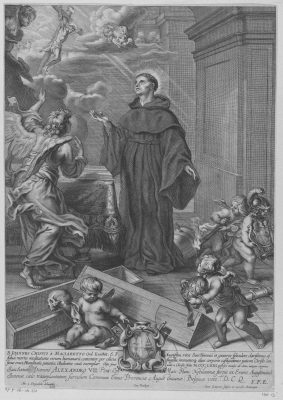 Here we see a more complex composition but with a clear reference to the work of Quellinus and de Jode: The cherub in Athena's helmet takes away the old coat of arms of the Chigi, and the other cherub points out to the new one, with papal symbols of St. Peter's keys, another cherub carries the papal tiara. Rijksmuseum dates the image as 1642 - 1685; most probably it is ca. 1655, when Fabio Chigi became Pope Alexander VII, and propaganda was focused on promoting his outstanding ancestor Giovanni, who died 300 years before. Giovanni Chigi is depicted here resurrected, accompanied by the archangel, and receiving the blessing from Jesus on the cross.
1 - Michael J. Walsh. A New Dictionary of Saints: East and West, p. 308.
2 - Nina Lamal. Publishing military books in the Low Countries and in Italy in the early seventeenth century in 'Specialist Markets in the Early Modern Book World', ed. Richard Kirwan, Sophia Mullins, Leiden: Koninklijke Brill, 2015, pp. 232-233.
Here we see a more complex composition but with a clear reference to the work of Quellinus and de Jode: The cherub in Athena's helmet takes away the old coat of arms of the Chigi, and the other cherub points out to the new one, with papal symbols of St. Peter's keys, another cherub carries the papal tiara. Rijksmuseum dates the image as 1642 - 1685; most probably it is ca. 1655, when Fabio Chigi became Pope Alexander VII, and propaganda was focused on promoting his outstanding ancestor Giovanni, who died 300 years before. Giovanni Chigi is depicted here resurrected, accompanied by the archangel, and receiving the blessing from Jesus on the cross.
1 - Michael J. Walsh. A New Dictionary of Saints: East and West, p. 308.
2 - Nina Lamal. Publishing military books in the Low Countries and in Italy in the early seventeenth century in 'Specialist Markets in the Early Modern Book World', ed. Richard Kirwan, Sophia Mullins, Leiden: Koninklijke Brill, 2015, pp. 232-233.
-
 The so-called Yoshirō-tsuba [与四郎鐔] with an iron plate of mokkō form densely decorated with floral arabesque and adorned with eight pierced, chiselled and inlaid brass roundels and signed on both sides 'Koike Yoshirō Izumi no Kami Naomasa'. Four of the roundels are pierced and have geometrical designs representing flowers (e.g. wood sorrel) or snowflakes. Four others are solid and represent family crests; on one side: Mulberry (kaji) – mon of the Matsunaga clan [松永氏], Bamboo Grass (sasa) – mon of the Takenaka clan [竹中氏]), Wild Geese (kari) – mon of the Shibata clan [新発田氏]), and Pine Needles (matsuba); on the other side: Nine Stars (kuyō) – the Hosokawa clan [細川氏], Paulownia (kiri) – the Toyotomi clan [豊臣氏]), Bamboo Leaves (take) – the Minamoto clan [源], and Seven Treasures (shippo) – Izumo Genji clan [出雲源氏]. Hitsu-ana obliterated with a nanako-treated pewter plug. Brass with rainbow patina. Artist: Koike Izumi no Kami Naomasa (Japanese, active late 16th – early 17th century). The Momoyama or early Edo period, end of the 16th to the first half of the 17th century (1574-1650). Size: 81.7 x 78.8 x 4.3 cm. Provenance: Dr. Kazutaro Torigoye. Special thanks to Markus Sesko for providing the translation of hakogaki. Hakokaki lid (outside): 小池与四郎 – Koike Yoshirō Hakokaki lid (inside): 銘曰小池与四郎 – Mei’etsu: Koike Yoshirō – Signed: Koike Yoshirō 和泉守直正 – Izumi no Kami Naomasa – Izumi no Kami Naomasa 木瓜形 鉄地 – Mokkōgata, tetsu-ji – Lobed shape, of iron 真鍮据紋象嵌 – Shinchū suemon-zōgan – with brass suemon-zōgan inlay 縦二寸七分横二寸六分 – Tate ni-sun shichi-bu, yoko ni-sun roku-bu – Height 8.2 cm, width 7.9 cm 右正真也 – Migi shōshin nari – Above described object is authentic 昭和廾九年八月十一日 – Shōwa nijūkyūnen hachigatsu jūichinichi – August 11, 1954 草堂「花押」– Sōdō + kaō – Sōdō [pen name of Torigoye Kazutarō, 鳥越一太郎] + monogram Ref.: (1) Tsuba Geijutsu-Ko by Kazutaro Torigoye, 1960; (2) Tsuba. An aesthetic study. By Kazutaro Torigoye and Robert E. Haynes from the Tsuba Geijutsu-kō of Kazataro Torigoye. Edited and published by Alan L. Harvie for the Nothern California Japanese Sword Club, 1994-1997, p. Yoshirō, 4. See also Yoshirō tsuba.
The so-called Yoshirō-tsuba [与四郎鐔] with an iron plate of mokkō form densely decorated with floral arabesque and adorned with eight pierced, chiselled and inlaid brass roundels and signed on both sides 'Koike Yoshirō Izumi no Kami Naomasa'. Four of the roundels are pierced and have geometrical designs representing flowers (e.g. wood sorrel) or snowflakes. Four others are solid and represent family crests; on one side: Mulberry (kaji) – mon of the Matsunaga clan [松永氏], Bamboo Grass (sasa) – mon of the Takenaka clan [竹中氏]), Wild Geese (kari) – mon of the Shibata clan [新発田氏]), and Pine Needles (matsuba); on the other side: Nine Stars (kuyō) – the Hosokawa clan [細川氏], Paulownia (kiri) – the Toyotomi clan [豊臣氏]), Bamboo Leaves (take) – the Minamoto clan [源], and Seven Treasures (shippo) – Izumo Genji clan [出雲源氏]. Hitsu-ana obliterated with a nanako-treated pewter plug. Brass with rainbow patina. Artist: Koike Izumi no Kami Naomasa (Japanese, active late 16th – early 17th century). The Momoyama or early Edo period, end of the 16th to the first half of the 17th century (1574-1650). Size: 81.7 x 78.8 x 4.3 cm. Provenance: Dr. Kazutaro Torigoye. Special thanks to Markus Sesko for providing the translation of hakogaki. Hakokaki lid (outside): 小池与四郎 – Koike Yoshirō Hakokaki lid (inside): 銘曰小池与四郎 – Mei’etsu: Koike Yoshirō – Signed: Koike Yoshirō 和泉守直正 – Izumi no Kami Naomasa – Izumi no Kami Naomasa 木瓜形 鉄地 – Mokkōgata, tetsu-ji – Lobed shape, of iron 真鍮据紋象嵌 – Shinchū suemon-zōgan – with brass suemon-zōgan inlay 縦二寸七分横二寸六分 – Tate ni-sun shichi-bu, yoko ni-sun roku-bu – Height 8.2 cm, width 7.9 cm 右正真也 – Migi shōshin nari – Above described object is authentic 昭和廾九年八月十一日 – Shōwa nijūkyūnen hachigatsu jūichinichi – August 11, 1954 草堂「花押」– Sōdō + kaō – Sōdō [pen name of Torigoye Kazutarō, 鳥越一太郎] + monogram Ref.: (1) Tsuba Geijutsu-Ko by Kazutaro Torigoye, 1960; (2) Tsuba. An aesthetic study. By Kazutaro Torigoye and Robert E. Haynes from the Tsuba Geijutsu-kō of Kazataro Torigoye. Edited and published by Alan L. Harvie for the Nothern California Japanese Sword Club, 1994-1997, p. Yoshirō, 4. See also Yoshirō tsuba.


